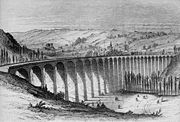
Barentin Viaduct
Encyclopedia

Viaduct
A viaduct is a bridge composed of several small spans. The term viaduct is derived from the Latin via for road and ducere to lead something. However, the Ancient Romans did not use that term per se; it is a modern derivation from an analogy with aqueduct. Like the Roman aqueducts, many early...
that crosses the Austreberthe River
Austreberthe
The Austreberthe is a 18-km river of Seine-Maritime. Its source is the village of Sainte-Austreberthe. It meets the Seine at Duclair.The Austreberthe is crossed by the Barentin Viaduct, a noteworthy 30 meter high brick railway bridge built in 1846, about 19-km from...
on the Paris–Le Havre line
Paris–Le Havre railway
The Paris–Le Havre railway is an important 228-kilometre long railway line, that connects Paris to the northwestern port city Le Havre via Rouen...
near to the town of Barentin
Barentin
Barentin is a commune in the Seine-Maritime department in the Haute-Normandie region in northern France.-Geography:A town of light industry and farming situated by the banks of the Austreberthe River in the Pays de Caux, some northwest of Rouen at the junction of the D6015, D143 and the D104 roads...
, Normandy
Normandy
Normandy is a geographical region corresponding to the former Duchy of Normandy. It is in France.The continental territory covers 30,627 km² and forms the preponderant part of Normandy and roughly 5% of the territory of France. It is divided for administrative purposes into two régions:...
, France
France
The French Republic , The French Republic , The French Republic , (commonly known as France , is a unitary semi-presidential republic in Western Europe with several overseas territories and islands located on other continents and in the Indian, Pacific, and Atlantic oceans. Metropolitan France...
, about 12 miles (19 km) from Rouen
Rouen
Rouen , in northern France on the River Seine, is the capital of the Haute-Normandie region and the historic capital city of Normandy. Once one of the largest and most prosperous cities of medieval Europe , it was the seat of the Exchequer of Normandy in the Middle Ages...
. It was constructed of brick with 27 arches, 100 feet (30 m) high with a total length of 600 yards (549 m). The British engineer was Joseph Locke
Joseph Locke
Joseph Locke was a notable English civil engineer of the 19th century, particularly associated with railway projects...
and the contractor Thomas Brassey
Thomas Brassey
Thomas Brassey was an English civil engineering contractor and manufacturer of building materials who was responsible for building much of the world's railways in the 19th century. By 1847, he had built about one-third of the railways in Britain, and by time of his death in 1870 he had built one...
.
Shortly after it was completed, after several days of heavy rain, the viaduct
Viaduct
A viaduct is a bridge composed of several small spans. The term viaduct is derived from the Latin via for road and ducere to lead something. However, the Ancient Romans did not use that term per se; it is a modern derivation from an analogy with aqueduct. Like the Roman aqueducts, many early...
collapsed on 10 January 1846. The cause of the collapse was never determined. One theory was that it had been filled with ballast before the mortar was dry. Another theory blamed the lime mortar
Lime mortar
Lime mortar is a type of mortar composed of lime and an aggregate such as sand, mixed with water. It is one of the oldest known types of mortar, dating back to the 4th century BC and widely used in Ancient Rome and Greece, when it largely replaced the clay and gypsum mortars common to Ancient...
which had been obtained from local sources. Whatever the cause, Brassey rebuilt the viaduct at his own expense, this time using lime of his own choice. The viaduct still stands and is in use today.

